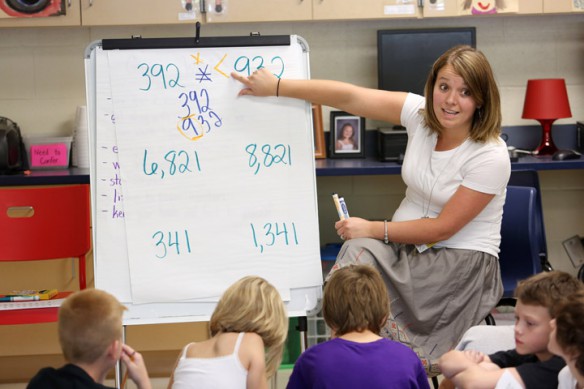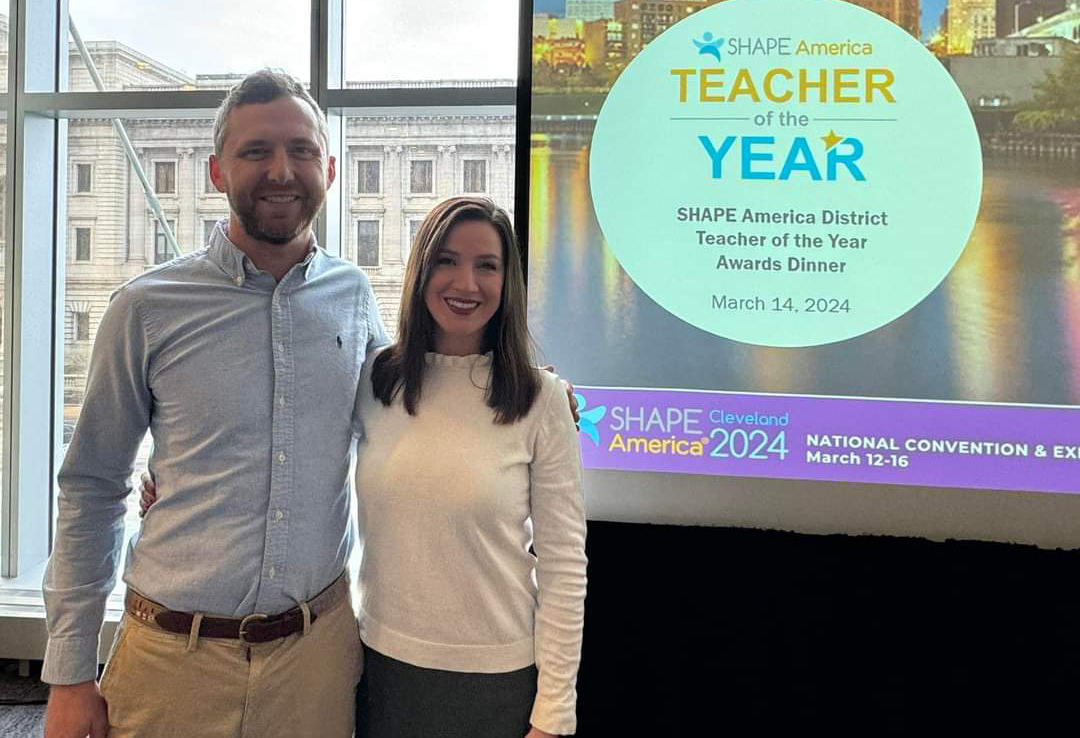
Krista Chatham reviews a worksheet with her 4th-grade class about how to compare numbers at Cartmell Elementary School (Carroll County). Photo by Amy Wallot, Aug. 21, 2012
By Susan Riddell
susan.riddell@education.ky.gov
Like many adults, Tim Sears, elementary mathematics consultant for the Kentucky Department of Education, was taught the phrase “Don’t ask why, just invert and multiply,” when he was a student learning about dividing fractions.
But according to the Kentucky Core Academic Standards for mathematics, students now must ask why. They also must learn how dividing fractions connects to other content areas and real world applications.
“We were taught procedural rules like that,” Sears said. “The standards now say build more conceptual learning through visual models, drawings and developing fraction number sense. We’re trying to connect fractions to kids’ everyday life and other content areas, especially science.”
Fractions has been a hot topic with state mathematics teachers this summer according to Sears, who facilitated several leadership network meetings prior to the start of the 2012-13 school year, and Seth Hunter, mathematics specialist with the Ohio Valley Educational Cooperative (OVEC) and president of the Kentucky Council of Teachers of Mathematics (KCTM).
Teachers agree.
“The largest gaps occur at the middle grades level,” said Sheila Peterson, who taught middle school mathematics for 10 years before taking a curriculum specialist position in the Grant County school district over the summer. “The gaps seem to occur more within fractions and the beginnings of algebra concepts.”
“With the standards being moved in all directions, teachers are trying to fill in grade-level gaps while continuing to teach the standards for their grade level, and that can be overwhelming at times,” added Krista Chatham, a 4th grade mathematics teacher at Cartmell Elementary School (Carroll County).
But Sears is impressed with the progress teachers are making.
“We are changing teacher practices,” he said. “We were first to jump in with the standards, and patience is important. It’s going to take some time to get the kids where they need to be, but we’re getting there. We have a statewide delivery plan and math initiatives that are in place. The mathematics leadership network and the educational co-ops are getting that message out there.
“Folks are still making sense of the standards,” Sears added. “Teachers are working hard to see what gives deeper understanding and addresses the gaps. Teachers are tasked with offering more depth and more conceptual understanding as well as the procedural understanding.”
Hunter said that through surveys mathematic stakeholders at both OVEC and KCTM noticed concerns not only regarding fractions, but other areas specific to different grade levels.
“With K-2, teachers want more assistance in understanding number and operations,” Hunter said. “It’s a huge topic.
“One of the specific things within that topic that the common core places a lot of value on and K-2 teachers have asked for a lot of help with is called structuring addition or structuring multiplication expressions or equations. With a number ‘puzzle’ like 3+4=7, the structuring has to do with rearranging those parts: 7-4=3; 7-3=4; 3+?=7. You’re jumbling all those parts up, and that’s a big concern teaching at K-2 level.”
Teaching fractions and dealing with the gaps are issues that also impact grades 3-5, Hunter said.
“That’s content that used to reside entirely in middle school,” Hunter said. “That is not only a typical concept for students to struggle with, for many teachers in grades 3-5 there are certain occasions they haven’t ever dealt with teaching fractions.”
In grades 6-8, Hunter said the biggest content request has been on ratios and proportions.
“That’s important because ratios and proportions concern linear relationships, and linear relationships are like the gateway drugs to high school algebra courses,” he said. “The importance of these topics, when looking at a learning trajectory and preparing for high school, is huge.”
While concerns still exist, teachers say they are gaining confidence thanks to progress made over the summer at various professional developments and other network meetings.
“The leadership networks have been great to be a part of,” Peterson said. “They have allowed teachers to discuss issues and try to resolve problems that we we’re facing in the classroom. We have focused on embedding cooperative learning tasks within the lessons. We also have looked at different questioning techniques (more formative questioning than summative).”
Formative assessment lessons allow teachers to assess student knowledge before and after the lesson, Chatham said.
“The students analyze their own work before and after the lesson to allow for the student self-reflection period,” Chatham said. “Also, in these types of lessons you allow students to be interactive with each other to make their own learning discoveries.
“From these lessons, the students start to have meaningful discussions about mathematics and how the concepts could be related,” she added. “If done correctly, in the right classroom environment, these lessons can be very powerful. However, teachers must realize that using these types of lessons is definitely a process. It takes time and won’t be perfect right away.”
Peterson echoed Chatham about patience being important in the process of adjusting to the mathematics standards.
“Colleges and the business industry will see better math students graduating from high school,” she said. “However, with any new product or system, it will take time for this to affect the students, and administration must help teachers in the endeavor.”
Another important concept is teacher reflection.
“We really have to change at how we look at teaching mathematics,” Chatham said. “Simply teaching students basic procedural skills they memorize isn’t going to cut it with these common core standards. Teachers have to be flexible and willing to change how they think about things.”
If teachers can do that, Kentucky will get where it needs to be, she said.
“I’m very proud to be a part of education in Kentucky,” Chatham added. “I believe we as teachers are working hard to improve instruction and learning for our students. This work can be difficult and frustrating, but it will help out students in the long run. We will see positive results in the end.”
MORE INFO …
Seth Hunter, seth.hunter2@education.ky.gov, (502) 694-2338
Tim Sears, tim.sears@education.ky.gov, (502) 564-2106, ext. 4131







Leave A Comment